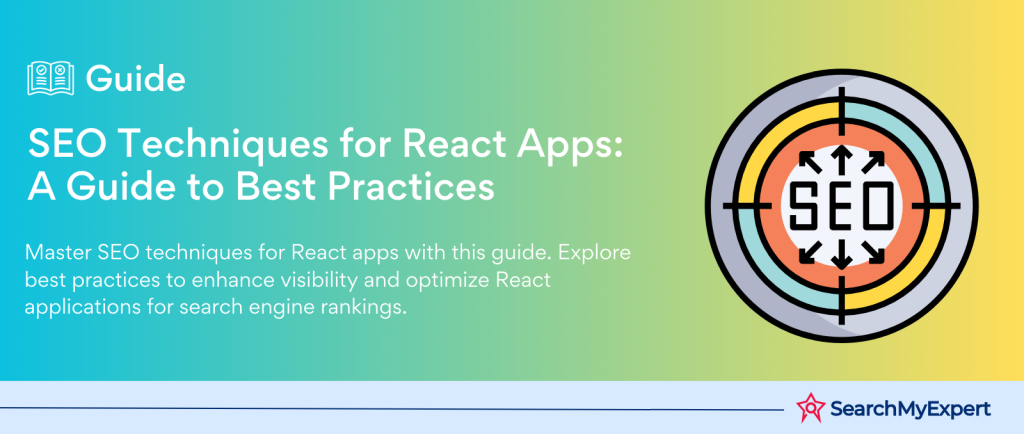Building SEO-Friendly React Applications
Understanding SEO and Its Importance for React Apps
What is SEO and How Does It Benefit Your React App?
Search Engine Optimization (SEO) is the art and science of making your website more visible to search engines. It’s about understanding what people are searching for online, the answers they seek, the words they use, and the type of content they wish to consume. Excelling in SEO means your website will be more likely to appear higher on the search engine results pages (SERPs), leading to more traffic.
For React applications, which are often single-page applications (SPAs), SEO is crucial. React apps are dynamic and content-rich, making them excellent for user experience but potentially challenging for search engine crawlers. Proper SEO practices ensure that your React app is discoverable, driving more organic traffic, improving user engagement, and potentially increasing conversion rates.
Unique Challenges of SEO for React Applications (SPAs)
React applications, particularly Single-Page Applications (SPAs), face unique SEO challenges:
- Crawling and Indexing: Traditional search engines crawl content generated on the server side. However, React apps render most content client-side, making it difficult for search engine bots to crawl and index the content.
- Initial Load Time: React SPAs often send a blank HTML page on the initial load with content rendered dynamically, which can be problematic for SEO.
- Navigation and Linking:
Without traditional page refreshes, tracking user navigation and ensuring all content is accessible through unique URLs can be challenging.
Overcoming these challenges requires a tailored approach, focusing on server-side rendering, optimizing load times, and ensuring all content is crawlable.
Key SEO Considerations for React Developers
React developers can enhance their app’s SEO through several key considerations:
- Server-Side Rendering (SSR):
Implementing SSR or using a framework like Next.js can significantly improve SEO. This approach renders the initial page on the server, making it accessible to search engine crawlers. - Dynamic Rendering:
As an alternative to SSR, a dynamic rendering serves a static HTML version of the page to bots while keeping the dynamic, user-centric version for regular users. - Rich Snippets and Structured Data:
Adding structured data using schema.org can help search engines better understand and index your content, potentially leading to better SERP placements. - Performance Optimization:
Fast load times are crucial for SEO. Optimizing your React app’s performance, including reducing JavaScript bundle sizes and implementing lazy loading, can improve search rankings. - Accessible and Crawlable Content: Ensure all content is accessible without JavaScript enabled, using techniques like progressive enhancement. This makes your app more accessible to both users and search engines.
- Proper Use of Meta Tags and Link Elements:
Dynamic meta tags and properly configured <link rel=”canonical”> tags can help address SEO issues related to duplicate content and page categorization.
Incorporating these considerations from the development phase ensures that your React application is not only user-friendly but also SEO-friendly, leading to better visibility and higher organic search rankings.
Choosing the Right Framework or Approach for SEO-Friendly React Applications
Static Site Generation (SSG) vs. Server-Side Rendering (SSR) vs. Hybrid Approaches
In the quest for SEO-friendly React applications, the choice between Static Site Generation (SSG), Server-Side Rendering (SSR), and Hybrid approaches is pivotal. Each has its merits and suits different project needs.
- Static Site Generation (SSG):
Here, pages are generated at build time. This method is superb for sites with content that doesn’t change often, offering blistering load times and SEO efficiency. It’s a boon for blogs, marketing websites, and documentation sites. - Server-Side Rendering (SSR): Pages are rendered on the server upon each request. SSR shines for dynamic content, enhancing SEO and initial page load time by serving fully rendered pages to browsers and bots alike. Ideal for e-commerce sites and social media platforms.
- Hybrid Approaches:
Modern frameworks allow developers to mix SSG and SSR, choosing the best approach for each page or component. This flexibility optimizes performance and SEO while catering to diverse content requirements.
Popular React Frameworks for SEO: Next.js, Gatsby, Nuxt.js, Razzle
Several React frameworks specialize in enhancing SEO:
- Next.js:
A front-runner for React applications, offering both SSR and SSG, making it a versatile choice for SEO-friendly development. Its automatic optimization and easy deployment amplify its appeal. - Gatsby: Focused on SSG, Gatsby pre-builds pages into static content, enhancing speed and SEO. It’s great for static sites with dynamic elements, leveraging a vast plugin ecosystem for extended functionality.
- Nuxt.js:
Though primarily for Vue.js, it’s worth mentioning for its similar capabilities to Next.js, offering SSR, SSG, and a hybrid mode. It ensures SEO-friendly sites with Vue.js. - Razzle:
Without specific build-time configurations, Razzle allows for SSR with React. It’s flexible, supporting various libraries and tools, making it a solid choice for custom server-rendered applications.
Factors to Consider in Framework Selection (Performance, Maintainability, Complexity)
Selecting the right framework entails balancing several factors:
- Performance: Assess how the framework handles load times, dynamic content, and user interaction. Speed is a cornerstone of SEO and user experience.
- Maintainability:
Consider the framework’s learning curve, community support, and documentation. A well-supported framework can significantly reduce development and maintenance efforts. - Complexity: Evaluate the complexity of implementing SEO strategies within the framework. Some may offer built-in SEO optimizations, while others might require more manual configuration.
The choice hinges on your project’s unique requirements — static sites may lean towards Gatsby for its speed, while dynamic applications might benefit from Next.js’s flexibility. Ultimately, the framework should streamline the development process, ensuring your React application is not just SEO-friendly, but also scalable and maintainable.
Content Optimization for SEO Impact in React Applications
Enhancing your React application’s SEO isn’t just about the technical setup; it’s also about the content. Here’s how to make your content work harder for your SEO goals.
Creating High-Quality, Relevant Content That Aligns with Search Intent
Quality and relevance are your watchwords. Dive deep into your audience’s search intent—what they’re looking for, the problems they’re trying to solve, and the questions they’re asking. Your content should be the answer they find. High-quality, relevant content boosts your SEO by increasing user engagement, lowering bounce rates, and earning backlinks, all signals that search engines reward with higher rankings.
- Research: Use keyword research tools to uncover the terms and phrases your audience uses.
- Answer Questions: Structure content to answer questions effectively. Use FAQs and how-to guides to directly address user queries.
- Value:
Every piece of content should offer value, whether it’s informational, educational, or entertaining.
Optimizing Page Titles, Meta Descriptions, and Open Graph Tags
These elements are crucial for SEO and social sharing:
- Page Titles: Keep them descriptive yet concise. Include primary keywords towards the beginning.
- Meta Descriptions:
These don’t directly impact rankings but influence click-through rates (CTR). Write compelling descriptions that include relevant keywords. - Open Graph Tags: Customize how your content appears when shared on social media. Use Open Graph tags to control the title, description, and image shown on platforms like Facebook and Twitter.
Structuring Content Effectively with Headings, Subheadings, and Lists
A well-structured article is easier for both users and search engines to understand. Use headings (H1, H2, H3) to organize content hierarchically and logically. Subheadings break up the text, making it more skimmable and improving user engagement. Lists (both bulleted and numbered) help condense information and highlight key points, further enhancing readability.
Internal Linking and External Linking Best Practices
Internal linking guides users and search engines through your site, connecting relevant content and distributing page authority across your site. Use descriptive anchor text that gives a clear idea of the linked page’s content.
External linking, when done judiciously, can boost your site’s credibility. Link to reputable sources to provide additional value to your readers. It’s a signal to search engines that you’re connected to and contributing to the broader web ecosystem.
Incorporating these content optimization strategies ensures your React application’s content is not only high-quality and user-focused but also finely tuned for maximum SEO impact.
Technical SEO for a Smooth User Experience in React Applications
To ensure your React application ranks well, it’s essential to nail the technical SEO. This step focuses on optimizing for a seamless user experience, which search engines prioritize.
Page Speed Optimization: Loading Times, Code Minification, Image Compression
Page speed is a critical SEO factor. Slow-loading pages can increase bounce rates and decrease rankings. Optimize your React app’s loading times by:
- Code Minification: Reduce the size of your JS and CSS files. Tools like UglifyJS and CSSNano can help.
- Image Compression:
Use tools like ImageOptim or TinyPNG to reduce image file sizes without sacrificing quality. - Lazy Loading: Implement lazy loading for images and components, ensuring they’re only loaded when needed.
Mobile-Friendliness and Responsiveness for All Devices
With the majority of web traffic coming from mobile devices, your React application must be mobile-friendly. Use responsive design principles to ensure your app looks and works great on all screen sizes. Test mobile usability with tools like Google’s Mobile-Friendly Test.
Accessibility Considerations for Diverse Users
Making your React app accessible to all users, including those with disabilities, is not only a moral imperative but also impacts your SEO. Use semantic HTML, ensure keyboard navigability, and follow the Web Content Accessibility Guidelines (WCAG) to improve accessibility.
Structured Data Markup for Richer Search Results
Structured data helps search engines understand your content better and can result in richer search results, like featured snippets. Use schema.org vocabulary to markup your content, and test it with Google’s Structured Data Testing Tool.
By focusing on these technical SEO aspects, you enhance not just the user experience but also your React application’s visibility and ranking on search engines.
Advanced Techniques for React-Specific SEO
Elevating your React application’s SEO requires diving into advanced techniques that tackle React-specific challenges, optimizing both performance and user engagement.
Pre-rendering and Client-Side Hydration for Dynamic Content
Pre-rendering transforms your React app into static HTML, making it instantly readable by search engines and users alike. When the app loads, client-side hydration kicks in, turning the static content into a fully interactive application. This dual approach ensures your dynamic content is both SEO-friendly and user-centric.
- Benefits: Immediate indexability and improved initial load time.
- Implementation:
Use tools like Next.js for seamless pre-rendering and hydration.
Code Splitting and Lazy Loading for Improved Performance
Code splitting divides your app’s code into smaller, manageable chunks, loading only the necessary pieces for the current route. Combine this with lazy loading, which defers the loading of non-critical resources at page load, to significantly boost your app’s performance.
- Impact: Faster page speeds and reduced bounce rates, which are positive signals for SEO.
- Tools: Leverage Webpack for code splitting and React’s React.lazy() for component-based lazy loading.
Server-Side Data Fetching and Content Hydration
Fetching data on the server and hydrating the client with the fetched data ensures that search engines see the fully rendered page, not just a shell. This method is particularly effective for dynamic content that relies on user data or third-party APIs.
- Advantage:
Enhances SEO by presenting a complete page to search engines upon initial crawl. - Approach:
Utilize Next.js or similar SSR frameworks that support server-side data fetching.
Progressive Web Apps (PWAs) for Enhanced User Engagement
Turning your React application into a PWA can significantly enhance user engagement. PWAs offer offline functionality, fast load times, and app-like experiences, which can improve user retention and engagement—a factor that indirectly influences SEO rankings.
- SEO Benefits: Increased time on site and lower bounce rates.
- Implementation: Use service workers and a web app manifest to enable PWA features.
These advanced techniques underscore the importance of a sophisticated, performance-oriented approach to SEO in React applications. By prioritizing speed, engagement, and content accessibility, you can significantly improve your app’s visibility and user experience.
Measurement and Tracking for Continuous Improvement in React Applications
Optimizing your React application for SEO is an ongoing journey. Measurement and tracking are crucial for understanding the impact of your strategies and making data-driven decisions for continuous improvement.
Setting Up Analytics Tools to Monitor SEO Performance
Analytics tools are your eyes and ears in the digital landscape. They help you monitor your website’s SEO performance, providing insights into traffic, user behavior, and conversion rates. Google Analytics and Google Search Console are foundational tools for tracking website performance and search visibility. Setting them up allows you to:
- Monitor Traffic Sources:
Understand where your visitors are coming from. - Analyze User Behavior: Track page views, bounce rates, and session durations.
- Identify Technical Issues: Discover crawl errors, broken links, and indexing problems.
Identifying Key Metrics and Tracking Progress Over Time
Key metrics provide a snapshot of your SEO health. These include:
- Organic Traffic:
The number of visitors coming from search engines. - Keyword Rankings:
How well your site ranks for targeted keywords. - Conversion Rates:
How effectively your traffic leads to desired actions. - Page Load Times:
Speed metrics that impact user experience and SEO. - Backlinks: The quantity and quality of external sites linking to your page.
Regularly tracking these metrics helps you gauge the effectiveness of your SEO efforts and identify areas for improvement.
A/B Testing and Iteration for Refinement
A/B testing, or split testing, involves comparing two versions of a webpage to see which one performs better in terms of SEO and user engagement. This methodical approach allows you to:
- Test Hypotheses: Whether it’s changing a title tag, modifying content, or adjusting a call-to-action, A/B testing provides empirical data on what works.
- Refine Strategies:
Use test results to refine your SEO tactics and content strategies. - Enhance User Experience: Optimize navigation, content, and design to improve engagement and conversions.
Continuous measurement, coupled with the iterative process of A/B testing, ensures your React application remains competitive and aligned with user needs and search engine algorithms.
Best Practices and Conclusion for SEO in React Applications
Crafting an SEO-friendly React application is a dynamic and ongoing process. Here’s how to ensure your strategy not only keeps pace with but also anticipates the ever-evolving landscape of search engine optimization.
Staying Informed About SEO Trends and Updates
SEO is not static. Search engines continuously refine their algorithms to improve the quality and relevance of search results. Staying updated with these changes is crucial:
- Follow Industry Leaders:
Subscribe to SEO thought leaders and platforms like Moz, Search Engine Journal, and Google’s Webmaster Blog. - Attend Webinars and Conferences: Engage with the SEO community through events and forums.
- Experiment:
SEO is as much art as it is science. Experiment with new strategies and technologies to see what works best for your application.
Building a Sustainable SEO Strategy for Your React App
A sustainable SEO strategy is built on quality content, technical excellence, and a user-first approach:
- Focus on User Experience:
SEO success is intrinsically linked to user satisfaction. Ensure your app is fast, accessible, and easy to navigate. - Quality Over Quantity:
Invest in high-quality, relevant content that addresses your audience’s needs and questions. - Technical SEO: Regularly audit your site for SEO health, addressing issues like broken links, slow loading times, and mobile responsiveness.
Resources and Tools to Support Your SEO Journey
Leveraging the right tools can significantly streamline your SEO efforts:
- Analytics and Performance: Google Analytics, Google Search Console, and SEMrush offer insights into traffic, performance, and keyword rankings.
- Content Optimization:
Tools like Yoast SEO (for WordPress sites) and Ahrefs help optimize content and track your site’s SEO performance. - Technical SEO: Screaming Frog SEO Spider and GTmetrix can help identify and fix technical SEO issues.
Conclusion
Building an SEO-friendly React application is an ongoing endeavor that extends beyond the initial launch. It requires a commitment to continuous learning, adaptation, and refinement. By staying informed, focusing on user experience, and leveraging the right tools, you can create a React app that not only meets the needs of your users but also excels in the competitive landscape of search engine rankings.
Experience innovative frontend solutions with our React Development Service Company.
Table of Contents
Toggle






